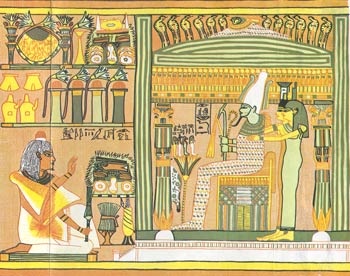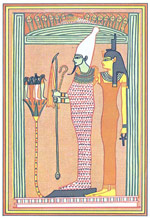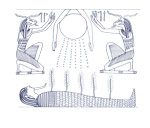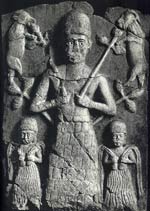Home
Ntcher Ausar in Kemet and Sumer
Father of Agriculture and the State
 Ausar, a pre-dynastic Ntcher, introduced agriculture and state government to Kemet beginning the Dynastic era. Ausar was the very embodiment of both - agriculture and the state - that would provide the key to abundance of food and resource creating the foundation for the unification of smaller communities into larger ones ultimately resulting in the Kemetic state. Throughout Kemetic history, in the iconography, Ausar is depicted as food in its various manifestations - plants (grains > wheat > bread, and fruit) and animals (birds, cattle, and fish) - and is depicted as the embodiment of the state as the seated Ntcheru upon the throne.
In his capacity Ausar is the foundation of the economy and commerce, having introducted the arts and sciences associated with both.
Ausar, a pre-dynastic Ntcher, introduced agriculture and state government to Kemet beginning the Dynastic era. Ausar was the very embodiment of both - agriculture and the state - that would provide the key to abundance of food and resource creating the foundation for the unification of smaller communities into larger ones ultimately resulting in the Kemetic state. Throughout Kemetic history, in the iconography, Ausar is depicted as food in its various manifestations - plants (grains > wheat > bread, and fruit) and animals (birds, cattle, and fish) - and is depicted as the embodiment of the state as the seated Ntcheru upon the throne.
In his capacity Ausar is the foundation of the economy and commerce, having introducted the arts and sciences associated with both.
Through migration and expansion, and following the directive of Ausar to share abundance, Kemetians took their knowledge of agriculture globally - to Asia Minor [Sumer], India [Harrapan / Dravidian], the Americas [Olmec] where they founded agricultural settlements named in honor of Ausar. In part of the Sumerian society, in northern Mesopotamia [modern day Iraq], one of the major Sumerian agricultural centers established was the city of Ausar (Assur). In some other areas of Sumer/Mesopotamia the attributes of Ausar were adopted and adapted to the names of other Ntcher (called Dingir in Sumer) like Marduk, Enki, Dagan, Oannes, Asari and others.
In Sumer / Mesopotamia, they practiced the 'way of life' learned from their ancestors in Kemet; for example, leadership took names after the Ntcher Ausar, and characteristics of the Ntcher were depicted in the iconography, and the 'word' of (i.e. the body of knowledge associated with) Ausar was canonized in the literature.
We find his name spelled several ways - including, among others, Ausar, Assur, Asari, Asar, and Ashur. However, the origin of Ausars name has been shown to mean water (A), earth/land (Sar), and sun (Ri), each of the elements necessary to nurture and grow a seed to fruit (see Bottero pp. 94-95). Incidently, 'A' is a water-name of the Ntcher Nu, 'Sar' is an earth-name of the Ntcher Geb, and 'Ri' is the same sun-name as the Ntcher Ra, each of whom in one instance or other proclaim to be the father of Ausar. 'The Book of Coming Forth' is one source for learning of their relationship to Ausar.
Following are some images of Ausar from Kemet and Sumer/Mesopotamia:
Image #1 Ausar is depicted as both food (his body in fish scales and his color green to represent vegetation), and as the embodiment of the State - in his hands he holds the symbols of Ruler and Leader. Ntcher Auset dons on her head the 'Seat-of-Government', and it is she who bears the Right/Rite to the throne.
Image #2 Ausar, the embodiment of agriculture, is depicted with plant-life growing from his body.
Image #3 Cuneiform writing depicting grain/wheat (also see depiction of Ausar as grain/wheat)
Image #4 Ausar, in Sumer, is depicted with vegetation growing from his body (circa: 1500 BCE), which is being eaten by a pair of goats. The lower half of his body is covered in a pattern either representing fish-scales, or building, the most likely depiction. Ausar is of the 'Anu' to whom building in early Kemet and Sumer is credited.
Ausar is flanked by water Dingir (life-forces), symbols of nourishment and abuncance.
Image #5 Ausar, in Sumer, is depicted as Oannes 'the Fish' who is credited with bringing civilization to Sumer (circa: 700-600 BCE).
| Depictions of Ausar from Kemet and Sumer | ||||
|---|---|---|---|---|
 |
 |
 |
 |
 |
Sources
Bottero, Jean (1992), Mesopotamia, University of Chicago Press - Image #3 (p. 94)
Budge, E.A.Wallis, (1899), The Egyptian Book of the Dead - Image #1
Hornung, Eric (1992), Idea Into Image: Essays on Ancient Egyptian Thought, Timken Publishers - Image #2 (p. 104)
Parrot, Andre, (1961), The Arts of Assyria, Golden Press, NY -
Image #4 (p. 7),
Image #5 (p. 74)